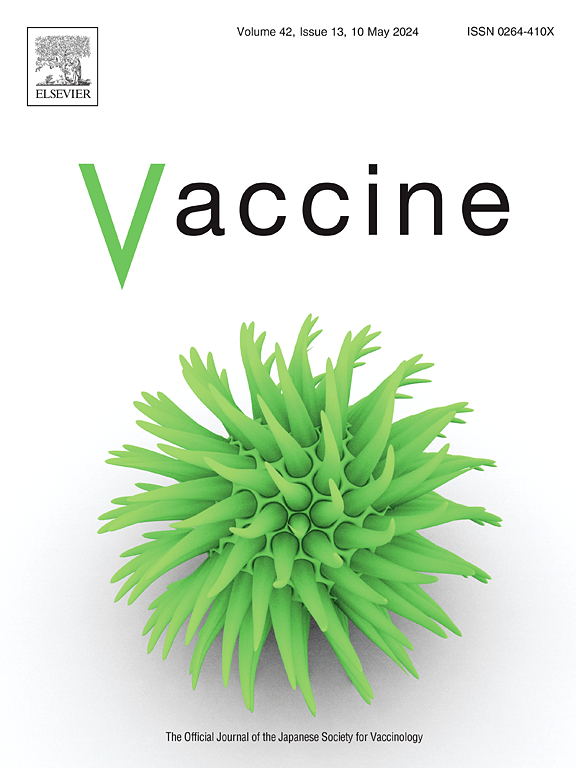Long-term efficacy and anamnestic response of hepatitis B vaccine derived from Chinese hamster ovary cell after 18–20 years
IF 4.5
3区 医学
Q2 IMMUNOLOGY
引用次数: 0
Abstract
To evaluate the long-term efficacy and anamnestic response of Chinese hamster ovary (CHO) cell-derived hepatitis B vaccine (CHO-HepB) after 18–20 years, a cross-sectional survey was conducted in seven communities in Zhengding County at the end of 2017. The birth cohort 1997–1999 vaccinated primarily with three doses of CHO-HepB were enrolled in the survey. The HBV serological markers were quantified using the Chemiluminescence method. The infection status of HBsAg-positive participants was determined by comparing their results with the previous data. For those with an anti-HBs antibody negative, the anamnestic response was evaluated by measuring anti-HBs antibody concentrations following a dose of HepB administration. A total of 1352 participants were enrolled, with the prevalence of HBsAg, anti-HBs, and anti-HBc being 0.4 %, 74.5 %, and 1.3 %, respectively. There was no significant difference in the HBV markers (HBsAg, anti-HBs and anti-HBc) between birth-year groups (P > 0.05). The geometric mean concentration (GMC) of anti-HBs antibodies among 1007 positive participants was 191 mIU/ml. No new infections or carriers were identified in the survey. Combined with the three previous surveys of the same birth cohort, the positive rates of HBsAg, anti-HBs, and anti-HBc remained largely unchanged over two decades following CHO-HepB vaccination. Of 248 participants who received a booster vaccination, 231 (93.1 %) showed an anti-HBs antibody positive with a GMC of 369 mIU/mL. Moreover, the positive rate and GMC of anti-HBs were higher in the CHO-HepB booster group compared to the Saccharomyces cerevisiae-HepB booster group. The long-term efficacy of the CHO-HepB remains stable for 18–20 years after primary vaccination, and a higher seroconversion rate of anti-HBs is observed following a booster vaccination of CHO-HepB. Given the absence of new infections or carriers over the past two decades, it appears unnecessary to administer a booster vaccination of HepB.
中国仓鼠卵巢细胞乙肝疫苗18-20年后的远期疗效及遗忘反应。
为评估中国仓鼠卵巢(CHO)细胞源性乙型肝炎疫苗(CHO- hepb) 18-20年后的长期疗效和记忆反应,于2017年底在正定县7个社区进行了横断面调查。1997-1999年出生的人群主要接种了三剂CHO-HepB疫苗。采用化学发光法定量检测HBV血清学标志物。通过将hbsag阳性参与者的结果与先前的数据进行比较来确定感染状况。对于那些抗hbs抗体阴性的患者,在给药一剂HepB后,通过测量抗hbs抗体浓度来评估遗忘反应。共有1352名参与者入组,其中HBsAg、anti-HBs和anti-HBc的患病率分别为0.4%、74.5%和1.3%。两组间HBV标志物(HBsAg、anti-HBs、anti-HBc)差异无统计学意义(P < 0.05)。1007名阳性受试者抗hbs抗体的几何平均浓度(GMC)为191 mIU/ml。调查中没有发现新的感染或携带者。结合之前对同一出生队列的三次调查,在CHO-HepB疫苗接种后的二十年中,HBsAg、anti-HBs和anti-HBc的阳性率基本保持不变。在248名接受强化疫苗接种的参与者中,231名(93.1%)显示抗hbs抗体阳性,GMC为369 mIU/mL。CHO-HepB强化组抗- hbs阳性率和GMC均高于酿酒酵母- hepb强化组。初次接种后,CHO-HepB的长期疗效在18-20年内保持稳定,并且在加强接种CHO-HepB后观察到更高的抗hbs血清转化率。鉴于在过去二十年中没有新的感染或携带者,似乎没有必要进行HepB加强疫苗接种。
本文章由计算机程序翻译,如有差异,请以英文原文为准。
求助全文
约1分钟内获得全文
求助全文
来源期刊

Vaccine
医学-免疫学
CiteScore
8.70
自引率
5.50%
发文量
992
审稿时长
131 days
期刊介绍:
Vaccine is unique in publishing the highest quality science across all disciplines relevant to the field of vaccinology - all original article submissions across basic and clinical research, vaccine manufacturing, history, public policy, behavioral science and ethics, social sciences, safety, and many other related areas are welcomed. The submission categories as given in the Guide for Authors indicate where we receive the most papers. Papers outside these major areas are also welcome and authors are encouraged to contact us with specific questions.
 求助内容:
求助内容: 应助结果提醒方式:
应助结果提醒方式:


